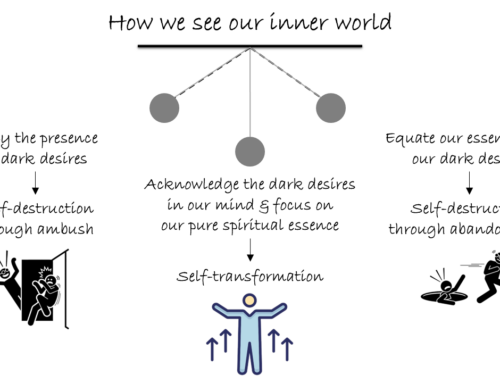Three characteristics each of spontaneous remembrance and conscientious remembrance
When memory is coupled with desire, attachment, or an emotional investment, it starts flooding, filling, and fueling our consciousness. On the other hand, when memories lack emotional investment, they become dormant, requiring us to recollect, restore, and rejuvenate them. This process involves actively reviving and strengthening those memories to make them vivid and meaningful again.
A significant principle in the Bhagavad-Gita is the discipline of remembering Krishna regularly, which evolves into a disposition of remembering him constantly. This progression from discipline to disposition hinges on the investment of emotion. In the Bhagavad-Gita (12.8), Krishna talks about spontaneous remembrance, and in 12.9, he explains what to do when spontaneous remembrance is not yet possible. The bridge between conscientious remembrance and spontaneous remembrance lies in the development of desire, which grows when we invest significant emotions into our practice.
The development of desire
Desire develops when we invest emotions deeply. When we strongly desire something, our memories of it begin flooding into our consciousness, often triggered by even minor stimuli. For example, if we love someone, seeing someone who resembles them or encountering anything associated with them triggers a flood of memories. These memories reconnect us with the appearance, nature, activities, and other aspects of that person.
In Sanskrit, this process of remembrance relates to the terms nama (name), rupa (form), guna (qualities), and lila (pastimes). The memories keep flooding into our consciousness until they completely fill it, leaving us unable to think of anything else. If we need to focus on something else, we must forcefully redirect our thoughts to that activity.
Memories not only fill our consciousness but also fuel it, driving us to act in ways that deepen our connection with the object of our love. This flooding, filling, and fueling is characteristic of spontaneous remembrance, as described in Bhagavad-Gita 12.8.
Conscientious remembrance
In contrast, conscientious remembrance requires effort. Memories do not work for us; we must work for the memories. For example, if we meet someone we knew long ago but did not form an emotional connection with, we may struggle to recall their name or details about them. This effort involves recollecting scattered impressions and restoring them to a more accessible place in our memory.
Conscientious remembrance is like searching for an object in our house that we don’t often use but suddenly need. After finding it, we place it in a more prominent location for easier future access. Similarly, recollected memories can be strengthened by dwelling on them and investing emotions into them, rejuvenating them so they become a vital force in our lives.
From conscientious to spontaneous remembrance
Conscientious remembrance of Krishna involves more than intellectual effort; it is also a practice of cultivating emotional connections. By gradually increasing emotional investment, our consciousness becomes more naturally attracted to Krishna. This steady emotional engagement transforms conscientious remembrance into spontaneous remembrance, where memories fill and fuel our consciousness effortlessly.
At this level, the desire for Krishna becomes habitual, natural, and eventually irresistible. This marks the point where we are deeply absorbed in him.

Summary:
- Emotional investment makes memories powerful, enabling them to flood, fill, and fuel our consciousness.
- Spontaneous remembrance occurs when memories work for us, while conscientious remembrance requires us to work for the memories.
- Conscientious remembrance involves recollecting, restoring, and rejuvenating memories, eventually bridging to the level of spontaneous remembrance.
Think it over:
- What are the three characteristics of memories at the level of spontaneous remembrance?
- Can you identify areas of your life where you experience spontaneous remembrance? How does it feel to have such active memories?
- What steps can you take to build the bridge from conscientious remembrance to spontaneous remembrance in your remembrance of Krishna?
***
12.09 My dear Arjuna, O winner of wealth, if you cannot fix your mind upon Me without deviation, then follow the regulative principles of bhakti-yoga. In this way develop a desire to attain Me.




















Leave A Comment